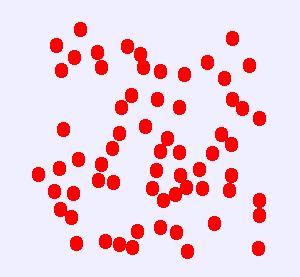Java Simulations for Statistical and
Thermal Physics

The following programs were written for the Statistical and Thermal
Physics curriculum development project and are part of the Open Source Physics project. The programs are released under the GNU
General Public License. The source code is available.
We recommend running these programs as a stand-alone application (a jar file) from the Launcher. The latter includes all the STP programs. You can also download individual simulations, but their names do not always correspond with the names of the programs in the text. The correspondence is summarized here.
The Video Capture button under Tools no longer appears to work properly on recent versions of Windows, probably due to Apple dropping support of QuickTime for Java libraries with the latest version of QuickTime. The workaround is to use a screen capture program rather than the internal Video Capture.
The goal of the simulations and calculations is to illustrate some
of the fundamental concepts in statistical mechanics. They can be used
as standalone programs or in conjunction with the texts such as Harvey Gould and Jan Tobochnik, Statistical and Thermal Physics, Princeton University Press (2010) or Daniel
Schroeder, An Introduction to Thermal Physics, Addison-Wesley
(2000). The Gould/Tobochnik text is also available online and may be freely downloaded.
- Approach to equilibrium. Explore some of the qualitative properties of macroscopic systems.
- Simple Monte Carlo simulation. A Monte Carlo simulation of noninteracting particles initially confined to one half of the box.
- Three partitions. A molecular dynamics simulation of a Lennard-Jones fluid initially confined in the middle third of the simulation cell.
- Two partitions. A molecular dynamics simulation of a Lennard-Jones fluid initially confined to half of the simulation cell.
- An ideal thermometer. Why is an extra degree of freedom called the demon an ideal thermometer?
- Ideal gas. The demon exchanges energy with an ideal gas. Illustrates that the demon can be interpreted as a thermometer.
- Einstein solid. The demon exchanges energy with an Einstein solid. Illustrates a universal property of the demon.
- Lennard-Jones fluid. Simulation shows the relation of the temperature as determined by the demon and the mean kinetic energy per particle.
- Sensitivity to initial conditions.
A molecular dynamics
simulation of a Lennard-Jones system in a specially prepared state.
- Random walks. What happens to a drunken sailor?
- Multiple coin toss. Monte
Carlo simulation of the
statistical properties of the outcome of the tosses of many coins.
- Binomial distribution. The plots illustrate how the width and relative width depend on N, the number of steps.
- Central limit theorem. A
demonstration of the probability
distribution of a random additive process.
- Monte Carlo estimation.
Estimation of the area under a curve
using the "hit or miss" method.
- A simple multiplicative random
process. The simulation illustrates the importance of rare events.
- Boltzmann probability. A
Monte Carlo simulation of an
ideal classical gas in one dimension in equilibrium with a heat bath.
- Simple thermal interaction. The number of states of two
harmonic solids that can exchange energy. What quantity becomes equal?
- The number of states for two Einstein solids that can exchange particles. What quantity becomes equal?
- An Einstein solid in equilibrium with a heat bath. A simulation of an Einstein (harmonic) solid using the Metropolis algorithm.
- Entropy and temperature. Calculation of the
entropy of two harmonic
solids that can exchange energy.
- Thermal equilibrium. A
molecular dynamics simulation of
two solids in thermal contact. What quantity becomes the same in
thermal equilibrium?
- Lennard-Jones fluid. A molecular dynamics or Monte Carlo simulation of a
liquid in two dimensions. Output includes the mean pressure,
temperature, heat capacity, and the radial distribution function.
- Hard disks. A molecular
dynamics or Monte Carlo simulation of hard disks.
Output includes the mean pressure, the mean free path, and the mean collision time.
- Ising model.
- Ideal gas integrals
- Ideal Bose gas. Calculation of
the chemical potential as a
function of temperature for fixed density for an ideal Bose gas.
- Ideal Fermi gas. Calculation
of the chemical potential as
a function of temperature for fixed density. The calculated chemical
potential is used to determine the mean energy.
- Number of states of a particle in a box. A comparison of the actual number of states to the asymptotic expression.
- Second virial coefficient. A calculation of the temperature-dependence of the second virial coefficient for the Lennard-Jones potential.
- Generalized demon algorithm. A generalization of the demon algorithm that yields the chemical potential as well as the temperature.
- Diffusive equilibrium. A simulation of a lattice gas with different chemical potentials.
- Chemical potential. An estimation of the chemical potential of a Lennard-Jones fluid using the Widom insertion method
- Potts model. Application of the Wang-Landau algorithm to the q-state Potts model.
- XY or planar model. A
simulation of the two-dimensional XY
model. See the development of vortices below the Kosterlitz-Thouless
transition.
- Fermi-Pasta-Ulam problem.
Simulation of a chain of
oscillators coupled by anharmonic springs.
- Percolation. The nature of
the geometrical phase
transition for site percolation on a square lattice is illustrated.
- RG percolation. Demonstration of the renormalization group method for site percolation.
- Quantum Monte Carlo. A Monte Carlo simulation of an ideal quantum gas in one, two, or three dimensions.
- Diffusion on a lattice. A
simple Monte Carlo simulation of
particles on a lattice with a maximum of one particle per site.
The programs were developed by Kipton Barros, Ranjit Chacko, Joshua Gould, Harvey
Gould, Natali Gulbahce, Peter Sibley, Jan Tobochnik, and Hui Wang. The Open Source Physics Java code library is described in Wolfgang
Christian, Open Source Physics: A User's Guide with Examples,
© Addison-Wesley, 2007.
Updated 18 January 2015.

